MARIANI’S
Virtual
Gourmet
March 26,
2017
NEWSLETTER
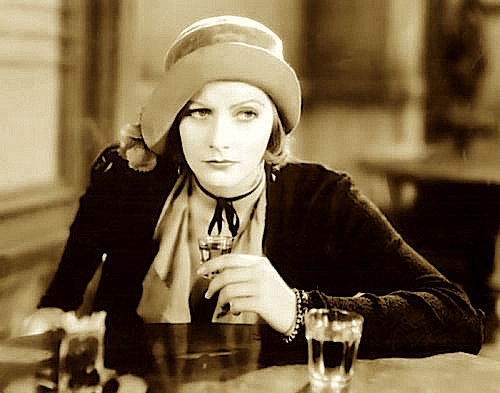
Greta
Garbo in "Anna Christie" (1930)
IN THIS ISSUE
BELFAST, Part One
By John Mariani
NEW YORK CORNER
RAYMI
By John Mariani
NOTES FROM THE SPIRITS CELLAR
NINETY-SIX BOTTLE OF
SCOTCH ON THE WALL
By John Mariani
❖❖❖
BELFAST
Part One
By John Mariani
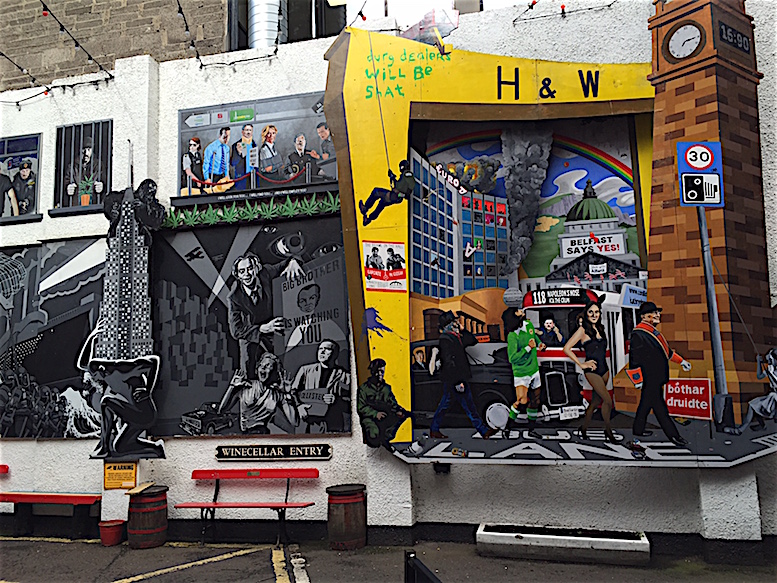
Several years ago a thoroughly clueless editor at Travel & Leisure magazine gasped at my proposal to write a story on Belfast, from which I’d just returned.
“Are you mad?” she screamed. “We don’t want our readers getting blown up in the streets!”
I remarked that there were plenty of places in the
world where that was as good a possibility, but
even in the days when Belfast had its
grievous and enduring troubles between Protestants
and Catholics, I still found it a beautiful city
of great historic interest. I
didn’t get to write the story.
had its
grievous and enduring troubles between Protestants
and Catholics, I still found it a beautiful city
of great historic interest. I
didn’t get to write the story.
Now, since the 1998 cease-fire Good Friday Agreement, Belfast has become a fine, thriving city, and its superb Georgian and Victorian buildings have been restored to all the color and brightness they possessed when they opened well more than a century ago, when red brick walls and slate roofs vied with the stone facades and marble columns of the Baroque Revival. In addition the arts flourish, not least in approved murals of great fancy (above) around Commercial Court near the Duke of York Bar (below).
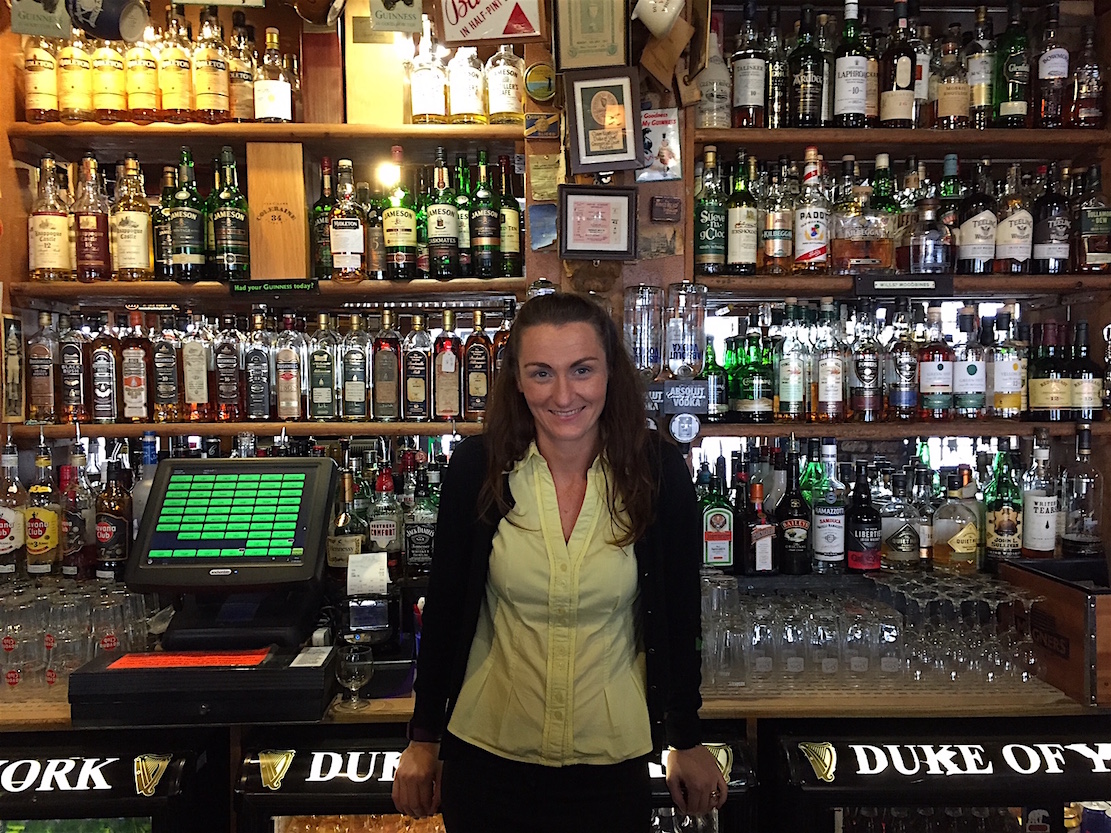 There
are still reminders of the bad times, poverty
still has large pockets, and the events of
political repression are still commemorated on
murals in vivid color. Relations between Catholics
and Protestants still simmer, and there is a
duality in citizens’ self image, some feeling
closer to Ireland, some to Britain. As
Belfast’s finest poet, Seamus Heaney, once wrote,
"Be advised my passport's green./No glass of ours
was ever raised to toast the Queen."
There
are still reminders of the bad times, poverty
still has large pockets, and the events of
political repression are still commemorated on
murals in vivid color. Relations between Catholics
and Protestants still simmer, and there is a
duality in citizens’ self image, some feeling
closer to Ireland, some to Britain. As
Belfast’s finest poet, Seamus Heaney, once wrote,
"Be advised my passport's green./No glass of ours
was ever raised to toast the Queen."
Years of economic stagnation have lifted, and the
peace dividend has resulted in Belfast now being
ranked in
the top five fastest growing regional economies in
the UK, with unemployment well under five percent
and an expanding boom in tourism. The
city can even claim to have Ireland’s tallest
building, the Obel Tower, completed in 2011. Such
hubris has, of course, caused widespread
construction, especially along the meandering
Langan River, with the result that housing prices
have skyrocketed.
As did the visionary leaders of Bilbao in bringing a Frank Gehry-designed branch of the Guggenheim Museum, the smart money in Belfast saw the city’s future along the waterfront by building the spectacular Titanic Quarter (formerly Queen’s Island), 185 acres now home to a very modern museum devoted to the doomed Cunard ocean liner, built in Belfast’s shipyards by Harland & Wolff, as well as to another Cunard liner, the SS Nomadic, and the Titanic’s Dock & Pump-House, whose length and breadth shows just how astoundingly huge the ship was. The surrounding area (right) is devoted to “urban village” space and parks, as part of a 30-year project of development.
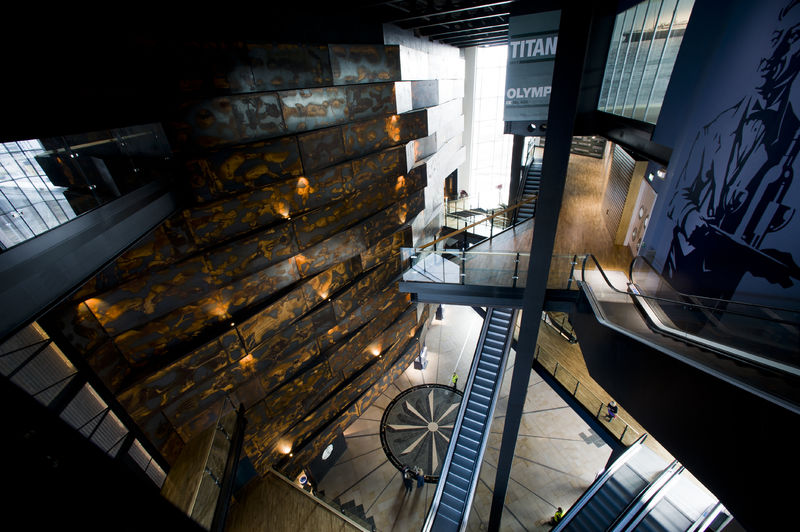 The RMS Titanic Museum (left), opened
in 2012, is a marvelous mix of the most modern
light and sound shows spread over nine interactive
galleries within five stories of anodized aluminum
forged into four pointed hull-like shapes by
Concept Design Architects and Todd Architects. The
tour takes you up a gangplank, through rooms of
historic artifacts—none, for ethical reasons,
plumbed from the sunken ship itself—showing the
regal majesty of the ship, its mighty power
stations and beautifully designed passenger rooms. There
are farewell letters and photos, ship’s logs, and
original blueprints. You trace the ship’s
departure from Southampton, England, on the
fateful voyage that ended so abruptly on April 15,
1912, and, although I found the depiction of the
moment of horror when the hull hit the iceberg
wanting in drama, the tour as a whole is
magnificently and tastefully done, and people peer
in silence at the facsimile of the great ship
sleeping in the sand 12,500 feet down. Small
wonder it draws a million visitors each year and
is indicative of the future of Belfast.
The RMS Titanic Museum (left), opened
in 2012, is a marvelous mix of the most modern
light and sound shows spread over nine interactive
galleries within five stories of anodized aluminum
forged into four pointed hull-like shapes by
Concept Design Architects and Todd Architects. The
tour takes you up a gangplank, through rooms of
historic artifacts—none, for ethical reasons,
plumbed from the sunken ship itself—showing the
regal majesty of the ship, its mighty power
stations and beautifully designed passenger rooms. There
are farewell letters and photos, ship’s logs, and
original blueprints. You trace the ship’s
departure from Southampton, England, on the
fateful voyage that ended so abruptly on April 15,
1912, and, although I found the depiction of the
moment of horror when the hull hit the iceberg
wanting in drama, the tour as a whole is
magnificently and tastefully done, and people peer
in silence at the facsimile of the great ship
sleeping in the sand 12,500 feet down. Small
wonder it draws a million visitors each year and
is indicative of the future of Belfast.
But the heart
and soul of the city are still along Great
Victoria Street, which becomes University Road on
its way to Queen’s University and connects to
other major thoroughfares like Donegall Road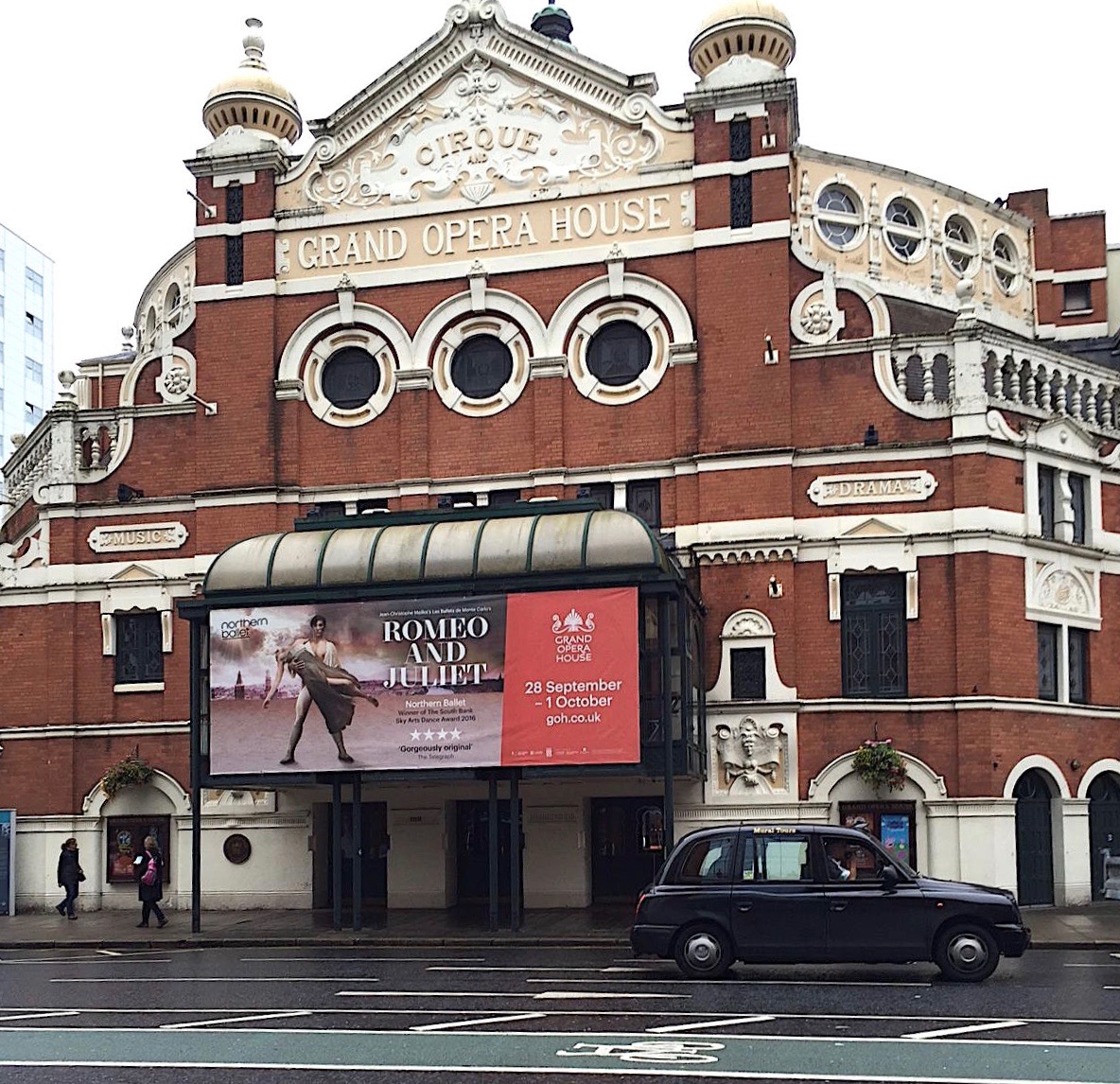 and
Shaftesbury Square.
Along its broad route lies the Grand Opera
House (right),
there since 1895 in all its Edwardian gaiety. During
the civil unrest in the city, when
few people ventured downtown, the
Opera was closed, destined for sale and demolition
but rescued at the last moment by the Arts Council, which
bought the building and restored it. Subsequently
two car bombs damaged the structure in the ‘90s,
causing the installation of blast walls around the
auditorium. Today the institution is run by the
Grand Opera House Trust Ltd., and a 2006 extension
has improved hospitality areas and access.
and
Shaftesbury Square.
Along its broad route lies the Grand Opera
House (right),
there since 1895 in all its Edwardian gaiety. During
the civil unrest in the city, when
few people ventured downtown, the
Opera was closed, destined for sale and demolition
but rescued at the last moment by the Arts Council, which
bought the building and restored it. Subsequently
two car bombs damaged the structure in the ‘90s,
causing the installation of blast walls around the
auditorium. Today the institution is run by the
Grand Opera House Trust Ltd., and a 2006 extension
has improved hospitality areas and access.
North of the Opera is the modern, glass-sided Castle Court Shopping Centre, with 80 stores and 15 eateries, then Great Victoria Street moves on to Saint Anne’s Cathedral, consecrated in 1904, almost destroyed by a German bomb in 1941, and topped with a 130-foot stainless steel spire named the “Spire of Hope” in 2007.
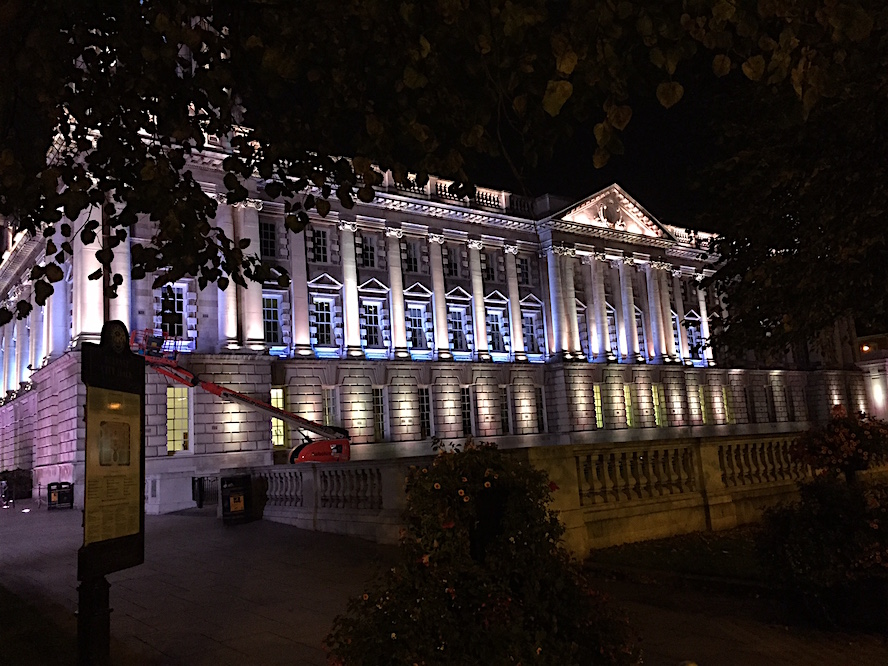 A few blocks east are the monumental
City Hall (left),
an Edwardian structure designed by Alfred Brunwell
Thomas well worth a look-see inside (tours are
offered), and the Linen Hall Library,
commemorating Belfast’s eminence as a linen
producer. Farther
east towards the river is the vast, award-winning
St. George’s Market, built between 1890 and
1896, which holds a weekly Friday Variety Market,
the City Food and Craft Market on Saturdays and
the Sunday Market.
A few blocks east are the monumental
City Hall (left),
an Edwardian structure designed by Alfred Brunwell
Thomas well worth a look-see inside (tours are
offered), and the Linen Hall Library,
commemorating Belfast’s eminence as a linen
producer. Farther
east towards the river is the vast, award-winning
St. George’s Market, built between 1890 and
1896, which holds a weekly Friday Variety Market,
the City Food and Craft Market on Saturdays and
the Sunday Market.
Nearby is the Albert Clock (below),
Belfast’s stand-in for London’s Big Ben, created
in 1865 to honor Queen Victoria’s late Prince
Consort. You
need not look too closely to see that, like Pisa’s
famous tower, the Albert 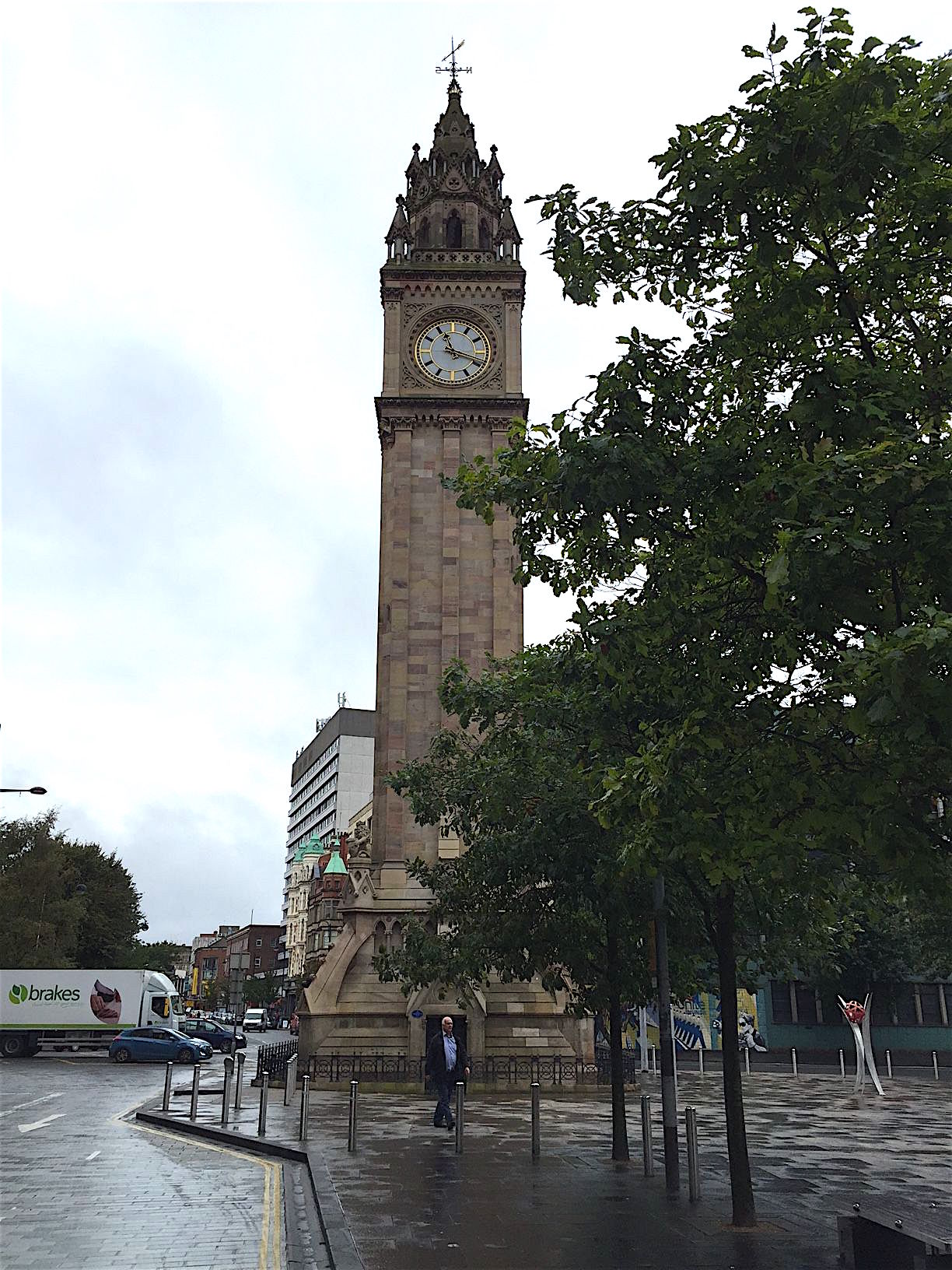 Clock,
having been built on marshy land, has tilted about
four feet over the past 150 years; it is also one
of the landmarks seen prominently in the fine 1947
film Odd Man
Out.
All these places I’ve described can easily
be visited in a morning and afternoon; save the
university and the Titanic Quarter for another
day.
Clock,
having been built on marshy land, has tilted about
four feet over the past 150 years; it is also one
of the landmarks seen prominently in the fine 1947
film Odd Man
Out.
All these places I’ve described can easily
be visited in a morning and afternoon; save the
university and the Titanic Quarter for another
day.
In the city’s western neighborhoods there is still a good deal that is run-down and derelict, and the scars of civil war and the continuing uneasiness are evident in the ironically named “peace lines,” long, somber walls dating to 1969, some of rusting iron, some of dark brick, rising up to 25 feet above the street. They serve as unyielding border barriers between Catholics and Protestants, an eerie echo of the Berlin Wall, and their gates are still shuttered at night by the police.
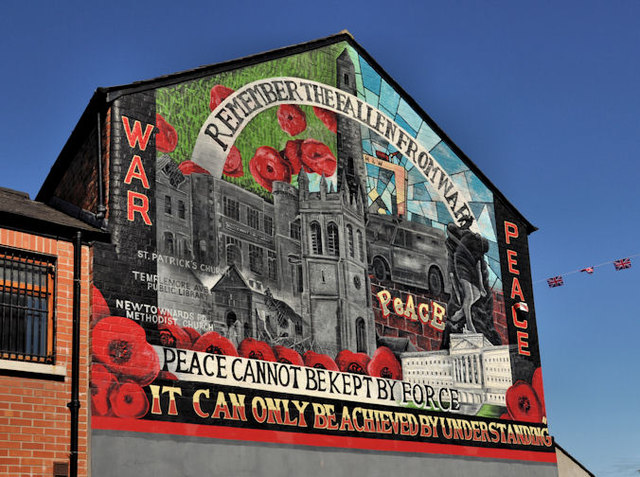 Sadly,
the walls have increased in size and number since
the Good Friday Agreement, and a 2012 study
indicated a majority of the residents insist they
are still necessary to prevent violence. Total
removal is now scheduled by 2023, but for now many
are painted with large murals and pictorial
graffiti showing the various heroes and villains
of both sides of the strife—murals I hope will be
preserved in museums in Belfast, when the
walls come tumbling down and its people come and
go with renewed faith in the future.
Sadly,
the walls have increased in size and number since
the Good Friday Agreement, and a 2012 study
indicated a majority of the residents insist they
are still necessary to prevent violence. Total
removal is now scheduled by 2023, but for now many
are painted with large murals and pictorial
graffiti showing the various heroes and villains
of both sides of the strife—murals I hope will be
preserved in museums in Belfast, when the
walls come tumbling down and its people come and
go with renewed faith in the future.
IF YOU GO. . .
• Check in at the new Welcome Centre Visitor Information, 8-10 Donegal Square, which offers free wi-fi access, tickets, and gifts. Utilize the website visit-belfast.com.
• Most banks are open Mon.-Fri. and ATMs are everywhere.
• Most shops are open daily till 6 p.m., on Thurs. 9 p.m.
• Belfast is a smoke-free city and most hotels no longer offer smoker’s rooms.
• Tipping at a restaurant is 10-15 percent on the bill.
❖❖❖
By John Mariani
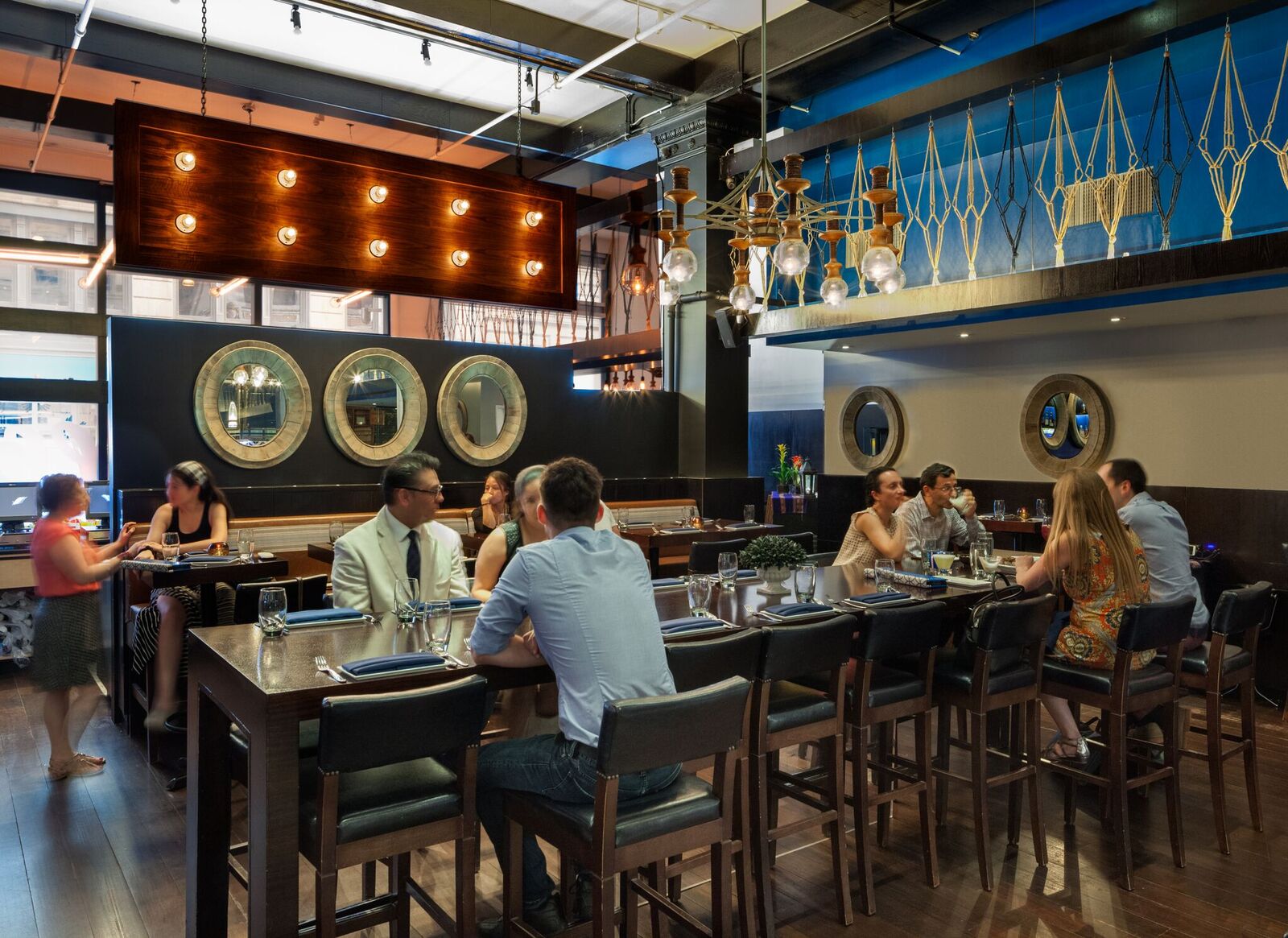 RAYMI
RAYMI43 West 24th Street (off Sixth Avenue)
212-929-1200
I claim no
first-hand knowledge of traditional Peruvian
cuisine, much less a modern take on it, but
if what the kitchen is cooking at Raymi is
any indication, then I regret what I’ve been
missing.
I do know that, thanks to Japanese immigrants,
Peruvian food adapted sashimi to ceviches—Nobu
Matsuhisa was once a resident of Peru—and the
ingredients on the menu at Raymi include items
like white soy, jasmine rice, bok choy, Chinese
sausage and others that give it a contemporary,
global flourish.
For me it all seems to work well, without
the forced clash of disparate foods that once went
under the useless term “Fusion Cuisine.”
Raymi’s
flavors
are well conceived, well thought out, and
beautifully executed, served up on ceramic plates,
woks, and in black skillets, the result of two
heads being better than one in executive chefs and
brothers Felipe and Jaime Torres (right). After
graduating from culinary school,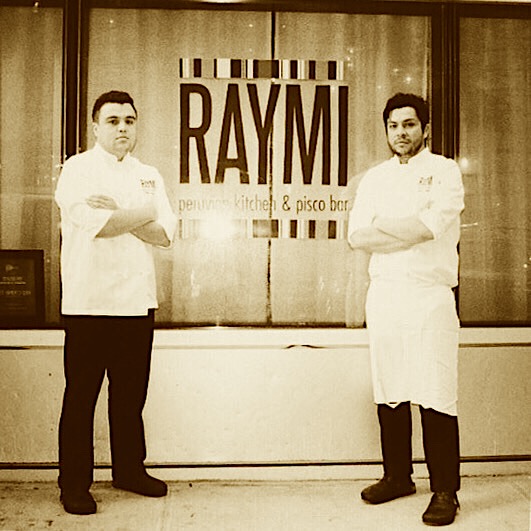 Felipe
worked at several of NYC’s finest restaurants,
including Eleven
Madison Park, Jean-Georges, and Esca, then
decamped to northern Italy before returning to
Peru to learn how his native cuisine had evolved.
Felipe
worked at several of NYC’s finest restaurants,
including Eleven
Madison Park, Jean-Georges, and Esca, then
decamped to northern Italy before returning to
Peru to learn how his native cuisine had evolved.
Jamie had studied business in Colombia before
joining his brother in Peru, then furthered his
education at Madrid’s celebrated Astrid &
Gaston. When
the opportunity to work together arose in NYC,
they became partners with others at a restaurant
named Nuella, which folded; then, they took
complete control and reconfigured the space as
their own.
My
words won’t do justice to the color and openness
of the dining areas, so I direct you to the photo
above to see the open kitchen and counter, the
good space between tables, and the use of lighting
to enhance its overall vitality. I am
not a fan of dining on the high chairs in one
room, but I got used to it quickly.
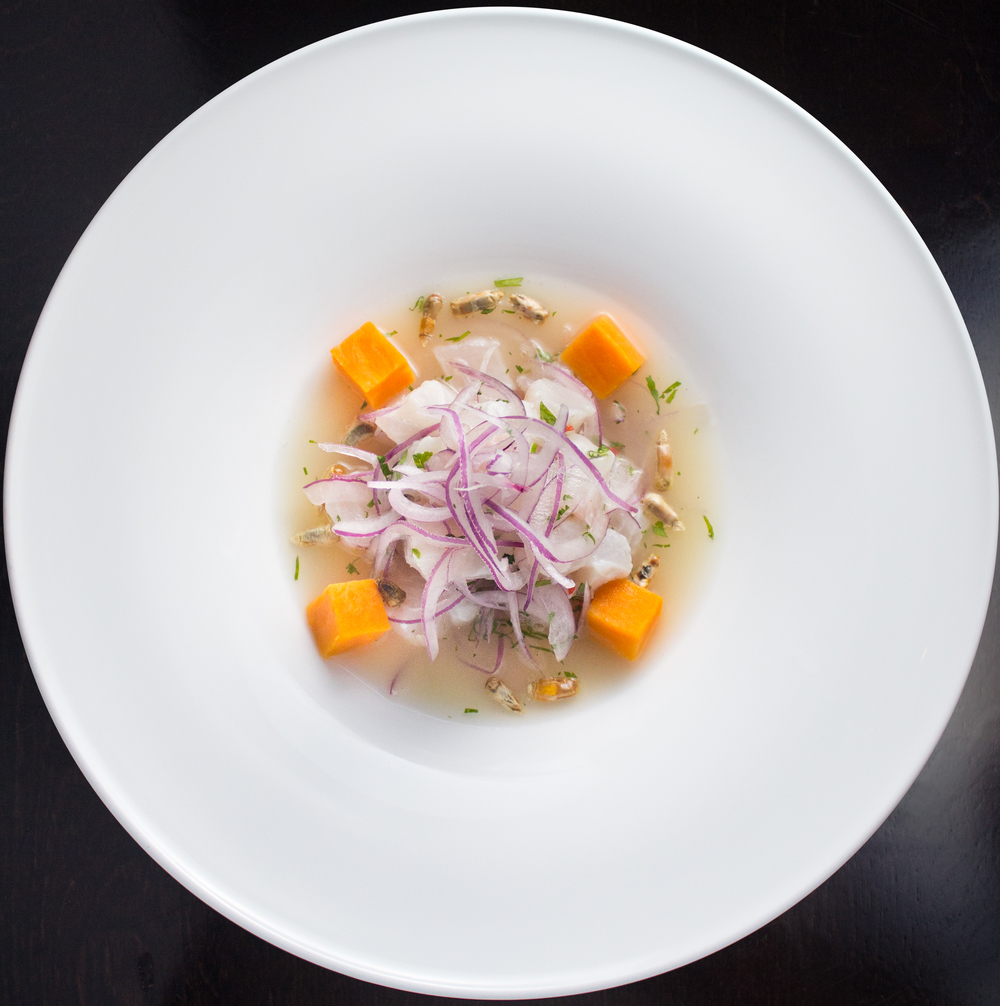 The service staff is
fleet-footed and cordial, and I could hardly have
asked for more geniality from our waitress, who
was, ironically, from Budapest.
The service staff is
fleet-footed and cordial, and I could hardly have
asked for more geniality from our waitress, who
was, ironically, from Budapest.
The wine list is modest, but you should try one of
the frothy Pisco cocktails.
There are several overlapping categories on the
menu—piqueos
(snacks), ceviche and toraditos, and
small
plates and salads, all easily shared by two
people. The
unexpected appearance of wontons ($13) on the menu
seems odd, but, filled with pork, aji amarillo,
ginger and scallion, they would pass muster in any
Chinatown dim sum house. The clasico ceviche
($16) comes with lustrous corvina, lime, red
onion, sweet potato, cilantro, and habanero chile
pepper (left),
all working in a spicy-tangy-sweet delicate
balance. Hamachi
toradito ($18) is flavored with aji amarillo,
aguayamanto
(Chinese
gooseberry), poppy seeds, crispy quinoa and a
touch of fresh thyme.
You could easily make a meal of these and a few
small plates, like the hearty charred octopus with
aji limo
mayo, endive, radicchio, and crispy quinoa ($18),
or the sweet pastel de
choclo ($12) toasted corn cake with roasted
mushrooms, their juice and watercress.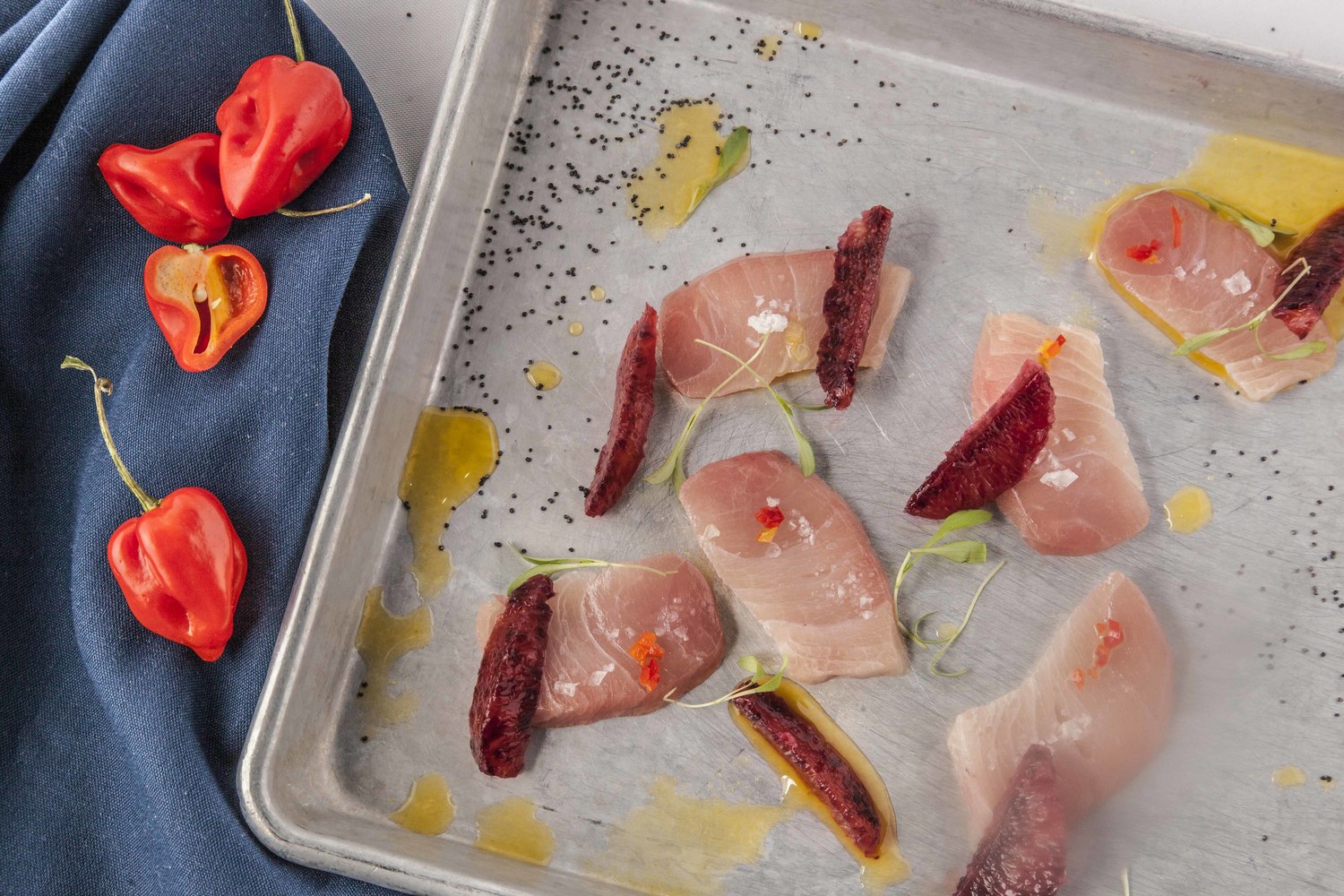
The next
category is entrees, from which I chose juicy carapulcra
($25), a plate of very rich roasted pork belly,
Peruvian potatoes, roasted peanuts, and salsa criolla,
and a jasmine rice dish called arroz chaufa
($26), abundant with egg, broccoli, ginger, char shui
chicken, shrimp, Chinese sausage, and peanuts.
“To Share” are dishes like a superbly rendered
duck confit with cilantro, jasmine rice, aji amarillo
mayo and crisp quinoa, all braised in dark beer
($24/$48). Nicely
chewy skirt steak is a popular cut in Peru, and
here it is lashed with spicy chimichurri, aromatic
roasted garlic and crispy yuca fries dusted with
parmesan cheese ($26/$50).
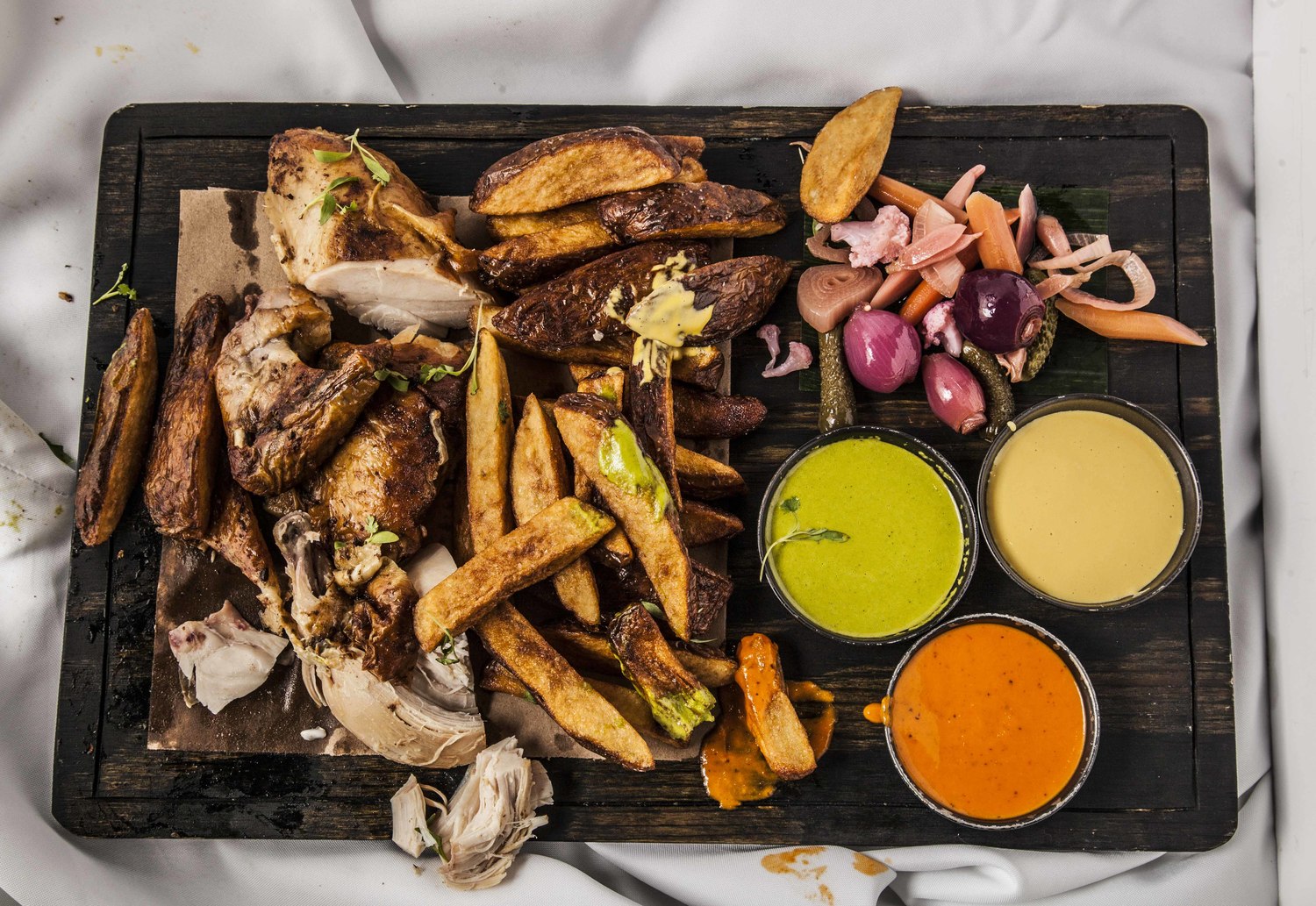 The plates are generous,
and a side dish of papa a la
huancainia ($12), baby potatoes, Alfonso
olives, watercress and a quail egg, is sufficient
for a table of four.
The plates are generous,
and a side dish of papa a la
huancainia ($12), baby potatoes, Alfonso
olives, watercress and a quail egg, is sufficient
for a table of four.
After all this, desserts are mere indulgences that
won’t make a difference in your opinion of what
preceded them.
The Torres brothers are
clearly committed to bringing their style of food
to New Yorkers’ attention, and they succeed in
both careful cooking and presentation. The added
spice, the crunch of peanuts, the unexpected Asian
notes make this kind of food very rare, if not
unique, in NYC, so Raymi becomes as much a
culinary education as it does a happy night out.
Raymi
is open for dinner nightly.
❖❖❖
NINETY-SIX BOTTLES OF
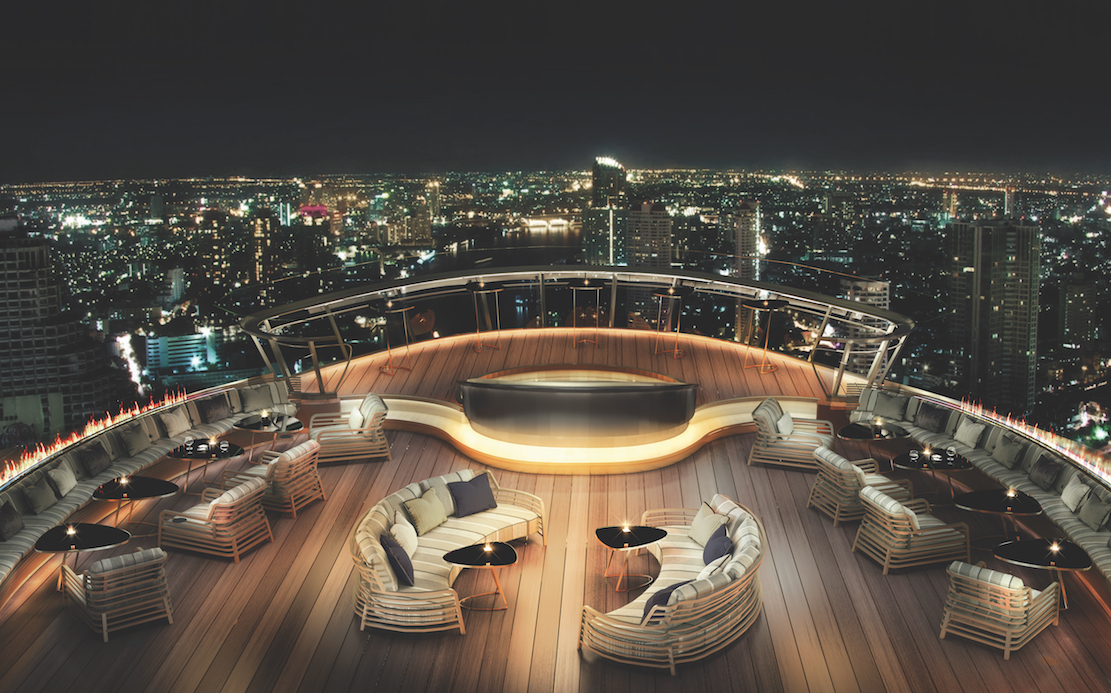
SCOTCH ON THE WALL
By John Mariani
To paraphrase the opening
of Thomas Wolfe’s Look
Homeward, Angel, “A destiny that leads the
Scots to Bangkok is strange enough, but to
create a unique Scotch whisky for a single hotel
halfway around the world from Speyside is
remarkable indeed.”
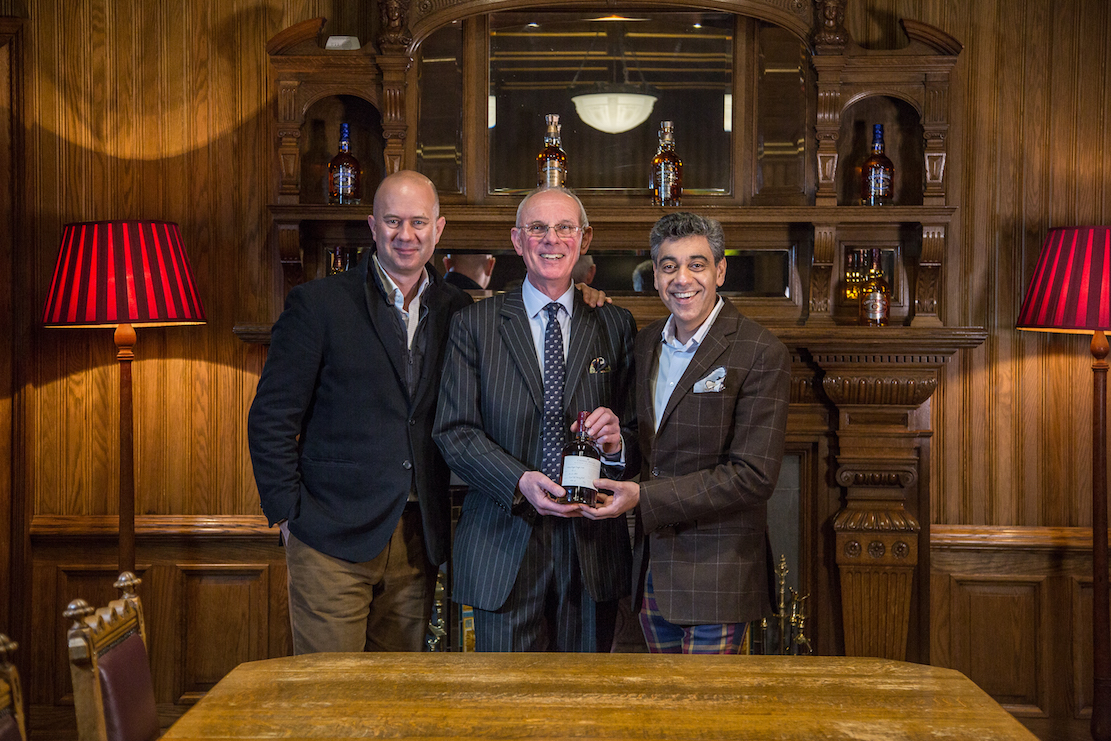 “This is the first time in
the history of the luxury whisky brand that it has
blended a whisky exclusively for one specific
partner,” Job said at an opening night party March
8 that I was in town to attend. “Only 96 bottles
of the Chivas Exclusive lebua Blend are available,
with each bottle individually numbered.”
“This is the first time in
the history of the luxury whisky brand that it has
blended a whisky exclusively for one specific
partner,” Job said at an opening night party March
8 that I was in town to attend. “Only 96 bottles
of the Chivas Exclusive lebua Blend are available,
with each bottle individually numbered.”
The bottling was created by Chivas Regal’s master
blending team led by Colin Scott (left, in the middle)
and is composed of selected whiskies distilled in
1985 or earlier and laid down in a selection of
casks, including American Oak. The
final blend was then left to rest in a First-Fill
Oloroso Sherry Butt for nine long years—something
Chivas has never done before. The whole experiment
was aimed at creating an elegant, very rich Scotch
whose fruitedness was complemented by the oloroso
sweetness and deep color absorbed from the barrel,
yet it still had to have the characteristic Chivas
style, which begins with the distillery blending
the malts and grains separately, the former from
Speyside, the latter from Paisley. Chivas is known
for its vanilla-toffee flavors and a hint of
chocolate. 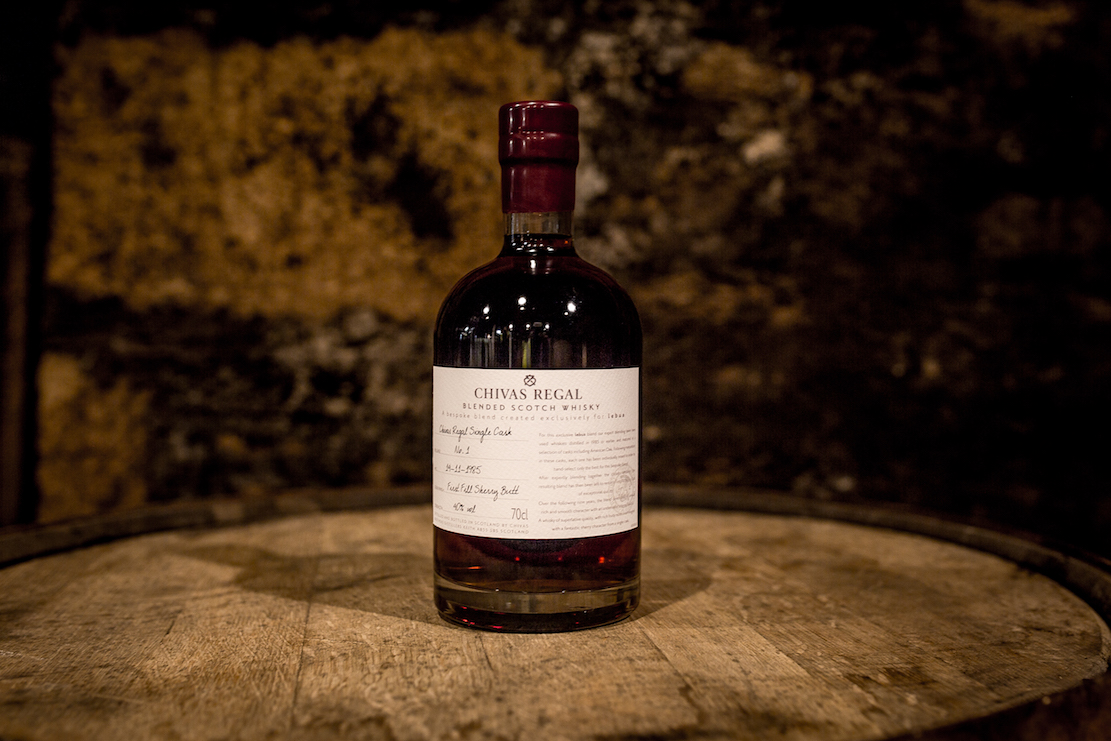
In an interview at the hotel with Colin Scott, I asked if this individual blend was something Chivas would be doing for other clients. “Never say never,” he answered, “but we promised this would be a one-time, unique effort on our part, made from the finest whiskies we have, so there will never be more than 96 bottles. That’s just 300 glasses, then it’s gone forever.”
The reason CEO Ohri gave for what is a canny marketing event was to give an added incentive for people to visit the hotel. “It’s very easy to sell rooms, especially when you’re in the deluxe market,” he told me, “so the food and spirits gives people more to talk about, draws them in, even if they’re not staying at the hotel. They spread the word. It’s the reason we do not hire celebrity chefs who are never in their restaurants; we stand by great cuisine, service and spectacular scenery.”
In fact, lebua competes mightily against a great
deal of luxury competition in a tough market—the
Peninsular, Mandarin Oriental, 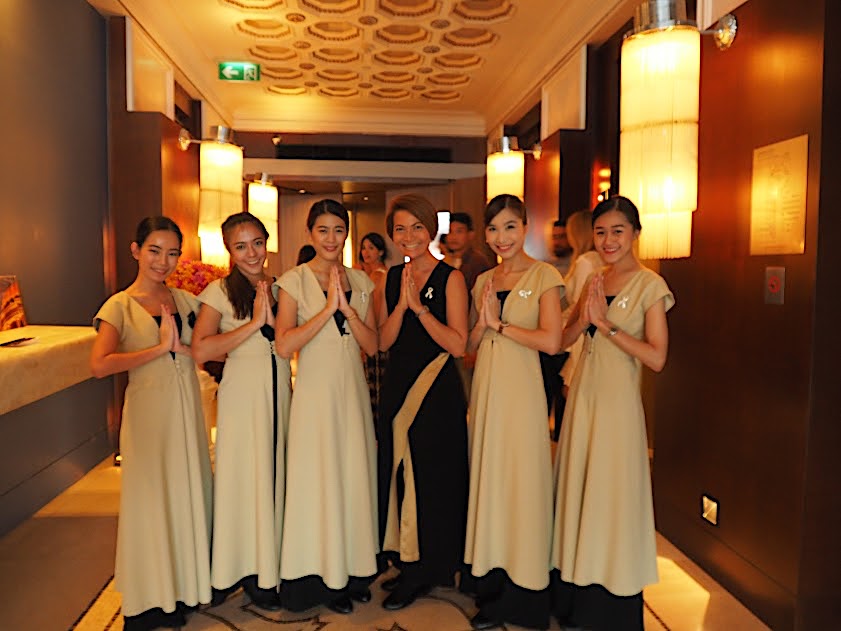 Shangri-La and St. Regis
hotels, with a Ritz-Carlton coming soon—all within
view of lebua’s 64th floor.
Shangri-La and St. Regis
hotels, with a Ritz-Carlton coming soon—all within
view of lebua’s 64th floor.
Alfresco 64 straddles other bars on that floor, which after 6 p.m. are usually packed with visitors who come as much for the food and drinks as the view. You come off the crowded elevator and are greeted by a number of charming women in traditional Thai dress, their palms together to greet you with a nod and a smile. Then you enter into Alfresco 64-A Chivas Bar, which is designed to look like a luxury yacht, jutting over the side of the building and set with lounge chairs and couches, with teak flooring. Glassware was specially designed for the cocktails served. (There is also a more private Heritage Room available for events.)
It seems unlikely those 96 bottles will last very long, even at $260 per glass—I decreased the supply by one tot—especially since on opening night a Chinese fellow bought two bottle outright, at $7,000 each.
❖❖❖
 HOW DO SAY “BIG OOPS!” IN FRENCH?
HOW DO SAY “BIG OOPS!” IN FRENCH?
The Michelin
Guide to France mistakenly awarded a coveted
star to a small café in the central French town of
Bourges called Bouche à Oreille (left)— “word of
mouth." When the owner, Véronique Jacquet,
heard thew news on the radio, she said, " I laughed out
loud. It
was impossible that this could happen to me. I run a
small working-class brasserie, nothing to do with a
gourmet restaurant.” A three-course menu costs $13.25
(12.50 euros) per person. Michelin mistook the
café for Bouche à Oreille in Boutervilliers, which has
had its star since 2015, where main courses start at
$29.75 (about 28 euros).
SOMEHOW WE HADN'T NOTICED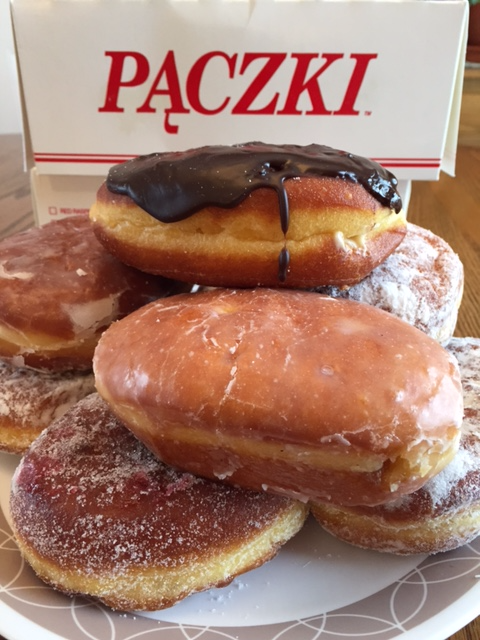
“What
Are
Paczki and Why Is Everyone Freaking Out About Them?” by
Lucas Peterson, Eater.com
(2/27/17)
❖❖❖
Any of John Mariani's books below may be ordered from amazon.com.
 The
Hound in Heaven (21st Century Lion Books)
is a novella, and for anyone who loves dogs,
Christmas, romance, inspiration, even the supernatural, I
hope you'll find this to be a treasured favorite.
The story concerns how, after a New England teacher,
his wife and their two daughters adopt a stray puppy found
in their barn in northern Maine, their lives seem full of
promise. But when tragedy strikes, their wonderful dog
Lazarus and the spirit of Christmas are the only things
that may bring his master back from the edge of
despair.
The
Hound in Heaven (21st Century Lion Books)
is a novella, and for anyone who loves dogs,
Christmas, romance, inspiration, even the supernatural, I
hope you'll find this to be a treasured favorite.
The story concerns how, after a New England teacher,
his wife and their two daughters adopt a stray puppy found
in their barn in northern Maine, their lives seem full of
promise. But when tragedy strikes, their wonderful dog
Lazarus and the spirit of Christmas are the only things
that may bring his master back from the edge of
despair. WATCH THE VIDEO!
“What a huge surprise turn this story took! I was completely stunned! I truly enjoyed this book and its message.” – Actress Ali MacGraw
“He had me at Page One. The amount of heart, human insight, soul searching, and deft literary strength that John Mariani pours into this airtight novella is vertigo-inducing. Perhaps ‘wow’ would be the best comment.” – James Dalessandro, author of Bohemian Heart and 1906.
“John Mariani’s Hound in Heaven starts with a well-painted portrayal of an American family, along with the requisite dog. A surprise event flips the action of the novel and captures us for a voyage leading to a hopeful and heart-warming message. A page turning, one sitting read, it’s the perfect antidote for the winter and promotion of holiday celebration.” – Ann Pearlman, author of The Christmas Cookie Club and A Gift for my Sister.
“John Mariani’s concise, achingly beautiful novella pulls a literary rabbit out of a hat – a mash-up of the cosmic and the intimate, the tragic and the heart-warming – a Christmas tale for all ages, and all faiths. Read it to your children, read it to yourself… but read it. Early and often. Highly recommended.” – Jay Bonansinga, New York Times bestselling author of Pinkerton’s War, The Sinking of The Eastland, and The Walking Dead: The Road To Woodbury.
“Amazing things happen when you open your heart to an animal. The Hound in Heaven delivers a powerful story of healing that is forged in the spiritual relationship between a man and his best friend. The book brings a message of hope that can enrich our images of family, love, and loss.” – Dr. Barbara Royal, author of The Royal Treatment.
 |
The Encyclopedia of American Food and Drink by John F. Mariani (Bloomsbury USA, $35) Modesty forbids me to praise my own new book, but let me proudly say that it is an extensive revision of the 4th edition that appeared more than a decade ago, before locavores, molecular cuisine, modernist cuisine, the Food Network and so much more, now included. Word origins have been completely updated, as have per capita consumption and production stats. Most important, for the first time since publication in the 1980s, the book includes more than 100 biographies of Americans who have changed the way we cook, eat and drink -- from Fannie Farmer and Julia Child to Robert Mondavi and Thomas Keller. "This book is amazing! It has entries for everything from `abalone' to `zwieback,' plus more than 500 recipes for classic American dishes and drinks."--Devra First, The Boston Globe. "Much needed in any kitchen library."--Bon Appetit. |
"Eating Italian will never be the same after reading John Mariani's entertaining and savory gastronomical history of the cuisine of Italy and how it won over appetites worldwide. . . . This book is such a tasteful narrative that it will literally make you hungry for Italian food and arouse your appetite for gastronomical history."--Don Oldenburg, USA Today. "Italian
restaurants--some good, some glitzy--far
outnumber their French rivals. Many of
these establishments are zestfully described
in How Italian Food Conquered the World, an
entertaining and fact-filled chronicle by
food-and-wine correspondent John F.
Mariani."--Aram Bakshian Jr., Wall Street
Journal.
"Equal parts
history, sociology, gastronomy, and just
plain fun, How Italian Food Conquered the
World tells the captivating and delicious
story of the (let's face it) everybody's
favorite cuisine with clarity, verve and
more than one surprise."--Colman Andrews,
editorial director of The Daily
Meal.com. "A fantastic and fascinating
read, covering everything from the influence
of Venice's spice trade to the impact of
Italian immigrants in America and the
evolution of alta cucina. This book will
serve as a terrific resource to anyone
interested in the real story of Italian
food."--Mary Ann Esposito, host of PBS-TV's
Ciao
Italia. "John Mariani has written the
definitive history of how Italians won their
way into our hearts, minds, and
stomachs. It's a story of pleasure over
pomp and taste over technique."--Danny Meyer,
owner of NYC restaurants Union Square
Cafe, The Modern, and Maialino.
|
 |
 |
 |
 |
 |
 |
 |
 |
 Everett Potter's Travel Report:
Everett Potter's Travel Report: 
 Eating Las Vegas
JOHN CURTAS has been covering the Las Vegas
food and restaurant scene since 1995. He is
the co-author of EATING LAS VEGAS – The 50
Essential Restaurants , as well as
the author of the Eating Las Vegas web site: www.eatinglasvegas.
He can also be seen every Friday morning as
the “resident foodie” for Wake Up With the
Wagners on KSNV TV (NBC) Channel 3 in
Las Vegas.
Eating Las Vegas
JOHN CURTAS has been covering the Las Vegas
food and restaurant scene since 1995. He is
the co-author of EATING LAS VEGAS – The 50
Essential Restaurants , as well as
the author of the Eating Las Vegas web site: www.eatinglasvegas.
He can also be seen every Friday morning as
the “resident foodie” for Wake Up With the
Wagners on KSNV TV (NBC) Channel 3 in
Las Vegas.

MARIANI'S VIRTUAL GOURMET
NEWSLETTER is published weekly. Editor/Publisher: John
Mariani.
Editor: Walter Bagley. Contributing Writers: Christopher Mariani,
Robert Mariani, Misha Mariani, John A. Curtas, Geoff Kalish, Mort
Hochstein, and
Brian Freedman. Contributing Photographers: Galina
Dargery. Technical Advisor: Gerry McLoughlin.
To un-subscribe from this newsletter,click here.
© copyright John Mariani 2017

